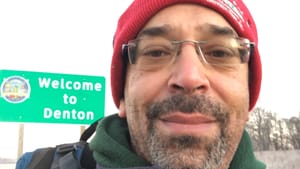Stay in the Loop
BSR publishes on a weekly schedule, with an email newsletter every Wednesday and Thursday morning. There’s no paywall, and subscribing is always free.
More than a walk in the park
Civil rights, one step at a time: Mural Arts Fellowship for Black Artists recipient Ken Johnston

In December 2019, Ken Johnston embarked on retracing the 265-mile journey that Harriet Tubman made along the Underground Railroad, although he didn’t quite anticipate making the long trek. “I was looking for a ‘low key’ walk after just completing a strenuous coastal walk of Puerto Rico to raise awareness of the effects of Hurricane Maria,” he says. What started as initially exploring Tubman’s trail from the Eastern Shore of Maryland heading north, Johnston then became engulfed by the history of Tubman’s journey.
In 1854, Tubman rescued her brother and eight others who were to be sold into slavery from the plantation that they lived on. Tubman had found out about the plan and rescued what she thought would be three people but turned out to be nine. “Through her network and resources, she was able to carry these people to Philadelphia in four days, which was a 142-mile journey,” he says. “It was an amazing feat that compelled me to walk further along the path.”
Then the coronavirus pandemic hit, causing Johnston to pause for nearly a year. Inspired to experience more of the history through walking, this past spring, Johnston completed his walk with a tracked total of 265 miles following the Underground Railroad path to New York, ending at Tubman’s statue in Harlem, New York. “It was an emotional journey, like many of my walks,” he says. “Too often, our ancestors, these freedom seekers, took to their graves how they made the impossible possible. I see my walks as a way to bring those spirits alive again.”
The art of walking
Johnston started walking long distances back in 2017 where he lived in Williamstown, Massachusetts. Overcoming personal struggles and dealing with the sedentary nature of working a 9-5 desk job at the time, Johnston started doing segment walks of 10 to 15 miles on the weekends. He says these walks allowed him to use new muscles, breathe fresh air, and really look at his surroundings. “Along these walks, I passed monuments of soldiers and generals representing the north’s involvement in the Civil War and it made me take a hard look at how we view monuments or markers of our freedom,” he says. Through this lens of what society deems as monuments, and seeing geographical and architectural landscapes up close, Johnston felt inspired to broaden his walks.
His “walks to freedom” honor the hard-fought civil rights enactments of the 1950s and 60s. The title is a nod to the June 23, 1963 civil rights march of the same name organized by the Detroit Council for Human Rights. The Detroit Walk to Freedom March was the largest demonstration for freedom ever held in the United States at the time, with over 125,000 people in attendance. His walks—first in Massachusetts and then later in Puerto Rico and Ireland—are a way to honor the history of the grounds and the ancestors who walked those same paths. In 2018, he completed a 400-mile solo walking journey from Selma, Alabama to Memphis, Tennessee for MLK50, visiting the many places Dr. Martin Luther King, Jr. either worked, pastored, or led peaceful protests.
The walking artist
Johnston considers himself a “walking artist.” He sees walking as a mode of art practice that is multi-sensory and physical. It is breathing, seeing, feeling, smelling, connecting, and living, engaging all his senses in a creative dance that sometimes leads to other forms of expression. Johnston says he represents the “length and breadth of people seeking equality from violence and oppression while acknowledging the intimate relationship with the land that we walk upon” through his walks. The walks communicate that more movement needs to happen when it comes to civil rights.
“Things have changed tremendously, yet as last year’s racial reckoning shows, there’s still a struggle for freedom,” he says. “These walks are a way to bring people together to remember our past while showing that more movements must happen for us to all have equal and balanced rights.”
“Too often, our ancestors, these freedom seekers, took to their graves how they made the impossible possible. I see my walks as a way to bring those spirits alive again.”

In May, Johnson became one of 20 award recipients of the Mural Arts Philadelphia Fellowship for Black Artists. The fellowship, presented by TD Bank, supports Black artists with unrestricted funding, financial planning sessions, and social media promotion and evaluative sessions from curators of HAHA magazine, Rush Arts Philadelphia, and StreetsDept.com. Johnston says he was shocked by the recognition.
As a walking artist, his practice may be different from his cohorts, though he sees it as an opportunity to showcase a different style of artwork based on the corporeal expression of movement that responds to social change. With the unrestricted funding from the fellowship, he plans to start an educational non-profit to share the stories of the courageous freedom seekers in Philadelphia he discovered while on these walks.
“Philadelphia has such a rich history of being a gateway to freedom, and there are so many sites that share those stories,” he says. “It’s my goal that through my non-profit, I can educate people [about] these brave souls who walked, marched, and protested, who persisted in the fight for freedom.”
Sign up for our newsletter
All of the week's new articles, all in one place. Sign up for the free weekly BSR newsletters, and don't miss a conversation.

 Jared Michael Lowe
Jared Michael Lowe